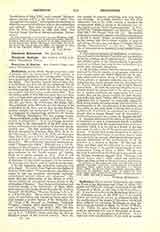

Dedication, a term which, though sometimes used of persons who are consecrated to God‘s service, is more properly applied to the “setting aside” of places for a special and sacred purpose (cf. Hastings, Dict. of the Bible). The Christian, indeed, believes that God is everywhere and that the Divine Immensity fills all space; but this faith does not exclude the idea of reserving a special spot in which the creature may hold communion with his Creator and worship Him. That the setting aside of this hallowed place was ever done with a certain show and ceremony is evident from the examples of Jacob (Gen., xxviii, 18), of Moses (Lev., viii, 10), and above all, of Solomon (III Kings, viii). This precedent of the Old Law was too obvious to be overlooked in the New, and we may be sure that the modern custom was consecrated by Apostolic usage. In a fragment of a martyrology ascribed to St. Jerome (cf. D’Achery, Spicilegium IV) this passage occurs: “Romae dedicatio primae Ecclesiae a beato Petro constructie et consecratae”. It is not strange, however, that owing to the persecutions of the first three centuries, references to the dedication of churches are extremely rare. The first authentic accounts of this kind are furnished by Eusebius (Hist. Eccl., X, iii, iv; De Vita Const., IV, xliii, in P.G., XX), and Sozomen (Hist. Eccl., II, xxvi in P.G., XLVII) in regard to the cathedral of Tyre (314) and Constantine’s church at Jerusalem. The well-known historical document entitled “Peregrinatio Silviae” (Etheria) has a full description of the celebration of the dedicatory festival of the church of Jerusalem as it was witnessed by our pilgrim-authoress in the fourth century (cf. Cabrol, Livre de la priere antique, p. 311). Here it will suffice to emphasize, in connection with the dedication of churches, (I) the ritual employed, (2) the minister, (3) necessity and effects, and (4) festival and its days.
1. In the beginning the dedication ceremony was very simple. A letter of Pope Vigilius to the Bishop of Bracara (538) states: “Consecrationem cujuslibet ecclesiae, in qua non ponuntur sanctuaria (reliquiae) celebritatem tantum scimus esse missarum” (We know that the consecration of any church in which shrines (relics) are not placed consists merely in the celebration of Masses). That the primitive ceremonial consisted mainly in the celebration of Mass, where there were no relics, is also shown from the old “Ordines Romani” (cf. Mabillon, “Museum Italicum”, II, in P.L., LXXVIII, 857). Where relics were used the ceremony of translating and depositing them under the altar formed a notable feature of the dedication rite (cf. “Ordo of St. Amand” in Duchesne, “Christian Worship“, London, 1903, Appendix; “Ordo of Verona” in Bianchini, ed., “Lib. Pont.”, III). The first complete formulary is found in the Gelasian Sacramentary (in P.L., LXXIV), which embodies the Roman liturgical usages of the seventh century. Here the rite consists of prayers, sprinklings with holy water, and blessings. So quickly, however, was this ritual elaborated that in the ninth century it attained the completeness which it enjoys at the present time (cf. the eighth-century “Liber Sacramentorum” in P.L., LXXVIII; “Ordines Romani“, ed. Martene, “De Ant. Eccl. Rit.”, III; Daniel, “Cod. Lit.”, I). The modern dedicatory ceremonial assumes two forms according as a church is simply blessed or solemnly consecrated. In the former case the function consists of prayers, sprinklings of holy water, and Mass (cf. Roman Ritual; Schulte, “Benedicenda”, p. 155, etc.). The solemn rite of consecration is described in the article Consecration.
The solemn ceremony of dedication, or consecration is found in the Roman Pontifical and is performed de jure by a bishop (see Consecration). The simpler rite, which is given in the Roman Ritual, is generally reserved to bishops, but may be also undertaken by a priest with episcopal delegation.
All churches, public oratories and semi-public, if destined for Divine worship in per petuum, must be at least blessed before the Sacred Mysteries can be regularly celebrated in them (Cong. of Rites, September, 1871). Purely private or domestic oratories may not be thus dedicated, but simply blessed with the Benedictio loci (cf. Roman Ritual or Missal) on each occasion Mass is said in them. As a rule the principal churches in every district should be consecrated in the solemn manner, but as certain conditions are required for licit consecration that are not always feasible (cf. Irish Ecclesiastical Record, April, 1908, p. 430) the ordinary simple dedication rite is regarded as practically adequate. Both forms render the place sacred, and contribute, as sacramentals, to the sanctification of the faithful, but they differ in this that while a church that is consecrated must, if polluted, be reconciled by a bishop, a church that is simply blessed may be reconciled in similar circumstances by a priest (cf. Roman Ritual).
Another difference in the effects of the two forms of dedication is that a consecrated church is entitled to celebrate each year the anniversary feast of its consecration, which is to be held as a double of the first class with an octave, by all the priests attached to the church. A church that is only blessed has no right to this anniversary feast unless per accidens, that is, when it is included in the special indult granted for the simultaneous celebration of the anniversaries of all the churches in a district or diocese. In this case the Office and Mass must be celebrated in every church, within the limits of the indult independently of their consecration (Cong. of Rites, n. 3863). Though any day may be selected for the dedication of a church, yet the Roman Pontifical suggests those “Sundays and solemn festive days” which admit the dedicatory Office and Mass, as well as the anniversary celebration.
PATRICK MORRISROE

